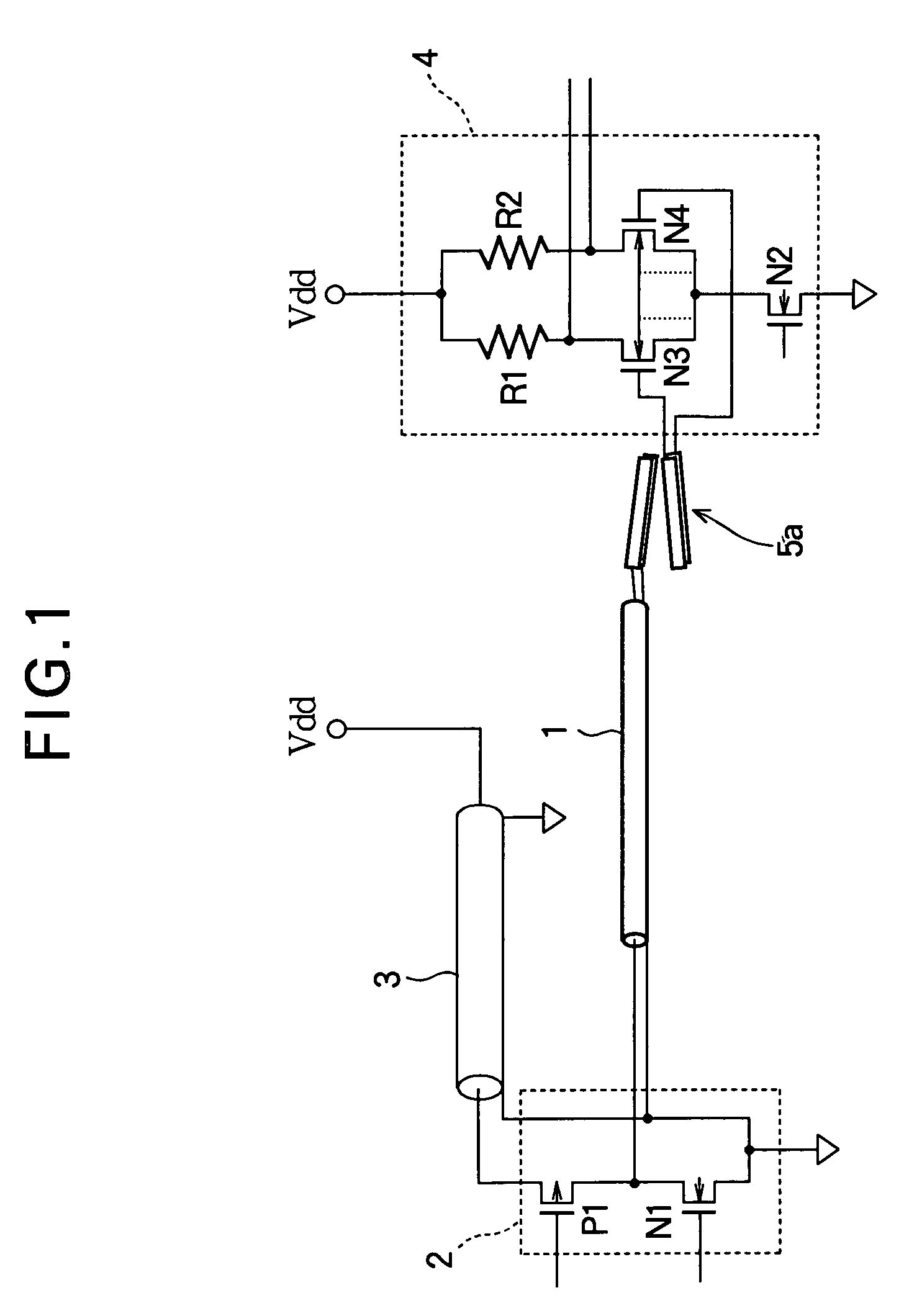Signal transmission apparatus and interconnection structure
- Summary
- Abstract
- Description
- Claims
- Application Information
AI Technical Summary
Benefits of technology
Problems solved by technology
Method used
Image
Examples
third embodiment
[0094]The third embodiment, having the double-coupler configuration with a terminating resistor shown in FIG. 3, operates the receiver 4 by signal transition energy alone. The terminating resistor 6a connected across the output end of the energy output line pair of the directional coupler 5c avoids energy collisions by allowing a brief discharge to take place when the logic level of the signal inverts (following the transition, the signal energy is converted uniformly to heat).
[0095]The fourth embodiment, having a single coupler at the transmitting end as shown in FIG. 4, is a simplified version of the third embodiment, applicable when the signal transmission line 1 approaches light-speed performance. The directional coupler 5b, which is connected to the transmitting end of the signal transmission line 1, is a high pass filter with a smooth passband from, for example, one hundred megahertz to several times ten gigahertz.
[0096]When the signal output from the driver is transmitted on ...
fifth embodiment
[0151]Although NMOS transistors N11 and N12 operate in synchronization with an input differential signal in the fifth embodiment in FIG. 5, there is no need for them to operate complementarily. The different drain voltages of NMOS transistors N11 and N12 cause a difference in their on-resistance, even if their dimensions are the same, but the difference in the on-resistance presents no problem, because the purpose of NMOS transistor N12 is to provide a reference to ground.
[0152]Since the on-resistance of the driver 12 may be fairly high, no further current-limiting measures may be necessary, but if the on-resistance of the transistors in the driver 12 is low, a resistor R10 may be inserted on the power-supply side as shown in FIG. 5.
[0153]Although the sense amplifier in the receiver 14 must be designed to detect small signal swings, this is possible within the realm of ordinary device design. The dimensions of the directional couplers 5b, 5c also enable them to be formed by use of o...
second embodiment
[0187]The embodiments described above may be modified for bi-directional transmission of digital signals by branching the transmitting and receiving ends of the signal transmission line and providing a driver and a receiver at each end. FIG. 26 shows an example of this modification based on the The directional couplers 5a, 5b obviate the need for tri-state drivers. The directional couplers 5b disposed between the drivers 2 and the signal transmission line 1 suffice to assure that when one driver is inactive, it will not interfere with the transmission of a digital signal by the other driver.
PUM
 Login to View More
Login to View More Abstract
Description
Claims
Application Information
 Login to View More
Login to View More - R&D
- Intellectual Property
- Life Sciences
- Materials
- Tech Scout
- Unparalleled Data Quality
- Higher Quality Content
- 60% Fewer Hallucinations
Browse by: Latest US Patents, China's latest patents, Technical Efficacy Thesaurus, Application Domain, Technology Topic, Popular Technical Reports.
© 2025 PatSnap. All rights reserved.Legal|Privacy policy|Modern Slavery Act Transparency Statement|Sitemap|About US| Contact US: help@patsnap.com



